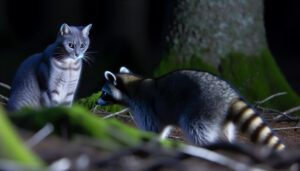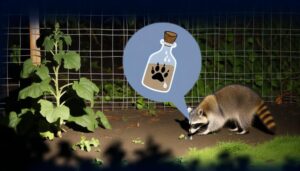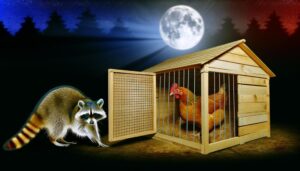Does Dog Hair Keep Raccoons Away?
Dog hair is commonly believed to deter raccoons, leveraging their olfactory sensitivity to predator scents. However, empirical evidence supporting this method remains limited.
Raccoons are highly adaptable and can potentially acclimate to the scent over time. While anecdotal reports highlight varying degrees of effectiveness, scientific studies specifically focusing on dog hair as a raccoon deterrent are scarce.
Additional controlled experiments are necessary to establish definitive recommendations. Utilizing dog hair as a deterrent may be more ecologically sustainable compared to synthetic repellents.
Exploring more insights will provide a thorough understanding of its effectiveness and application strategies.

Key Takeaways
- Dog hair can deter raccoons by triggering their olfactory avoidance response to predator scents.
- Effectiveness of dog hair as a raccoon deterrent varies significantly among users.
- Replacing dog hair frequently is essential for maintaining its deterrent effect.
- Limited empirical evidence exists, with most support coming from anecdotal reports.
- Combining dog hair with other deterrents may enhance overall effectiveness.
Understanding Raccoon Behavior
Understanding raccoon behavior requires a thorough examination of their foraging habits, social structures, and adaptive strategies in diverse habitats. Raccoons (Procyon lotor) exhibit omnivorous foraging behaviors, consuming a varied diet including fruits, insects, and small vertebrates.
Their social organization often involves solitary or mother-offspring groupings, although temporary aggregations may occur in resource-rich environments. Adaptability is a hallmark trait, enabling them to thrive in urban, suburban, and rural settings.
This adaptability is facilitated by their dexterous forepaws and acute problem-solving skills, which allow them to exploit a wide range of food sources and habitats. Understanding these behaviors is essential for developing effective management strategies to mitigate human-wildlife conflicts and ensure coexistence in shared environments.
The Myth of Dog Hair
While raccoons display remarkable adaptability and complex behaviors, a common belief persists that dog hair can act as a deterrent for these resourceful creatures. This notion is rooted in the assumption that the scent of a predator will discourage raccoons from entering a specific area.
However, empirical evidence to support this claim is scant. Scientific inquiries into raccoon deterrents have shown mixed results, often highlighting the limited effectiveness of olfactory-based methods.
Additionally, raccoons have demonstrated the ability to acclimate to various scents over time, reducing the potential deterrent effect of dog hair. Consequently, while anecdotal reports suggest some efficacy, rigorous studies are necessary to substantiate the validity of this widely-held belief in wildlife management practices.
How Dog Hair Might Work
Dog hair as a potential raccoon deterrent operates on the principle that the scent of a predator could trigger an instinctual avoidance response in raccoons. This concept leverages the olfactory sensitivity of raccoons, which allows them to detect the presence of potential threats in their environment.
When raccoons encounter the scent markers left by dogs, they may interpret these as indicators of a nearby predator, prompting them to vacate the area. This behavioral response is rooted in an evolutionary survival mechanism aimed at reducing encounters with predators.
Scientific Evidence
To evaluate the efficacy of dog hair as a raccoon deterrent, it is important to examine the scientific evidence supporting this claim. Current research on interspecies scent-based repellent mechanisms remains sparse.
Some studies suggest that predator scents can elicit avoidance behaviors in prey species, potentially including raccoons. However, empirical studies specifically measuring raccoon responses to dog hair are limited. One study on olfactory cues revealed that raccoons showed aversion to areas marked by predator urine, implicating scent as a contributory factor.
Nonetheless, the evidence remains inconclusive regarding dog hair alone as a significant deterrent. Further controlled experiments are required to substantiate these findings and offer definitive recommendations for those seeking humane raccoon management strategies.
Anecdotal Accounts
Anecdotal accounts from pet owners and gardeners frequently suggest that scattering dog hair around gardens and property perimeters can deter raccoon activity. These observations, while not rigorously tested, offer insights into the practical experiences of individuals attempting to protect their vegetation and property. Reports vary significantly in terms of effectiveness, with some users noting a marked decrease in raccoon visits, while others report negligible impact.
| Method | Reported Effectiveness | User Comments |
|---|---|---|
| Scattering Hair | High | Significant decrease noted |
| Hanging Sacks | Moderate | Mixed results |
| Mixing in Soil | Low | Minimal impact observed |
| Combining Methods | Variable | Success dependent on combination |
| Reapplication Frequency | Essential | Effectiveness wanes over time |
These variances underscore the necessity for more systematic investigation to substantiate these anecdotal claims.
Other Natural Deterrents
In addition to dog hair, other natural deterrents such as predator urine scents and motion-activated sprinklers have shown efficacy in raccoon management.
Predator urine scents exploit the raccoons' instinctual fear responses, thereby reducing their presence in targeted areas.
Meanwhile, motion-activated sprinklers provide an immediate and non-lethal deterrent by startling raccoons with unexpected bursts of water.
Predator Urine Scents
Predator urine scents have been scientifically recognized as effective natural deterrents for raccoons. Research indicates that the olfactory senses of raccoons are highly sensitive, enabling them to detect the presence of potential predators through scent markers.
Predator urine, such as that from coyotes or foxes, triggers an instinctual fear response in raccoons, prompting them to avoid areas where such scents are present. The efficacy of these deterrents is supported by empirical studies demonstrating reduced raccoon activity in treated environments.
For those committed to humane wildlife management, utilizing predator urine scents offers an evidence-based approach to deterring raccoons without causing harm. Employing these natural deterrents aligns with broader conservation goals and ethical wildlife practices.
Motion-Activated Sprinklers
Motion-activated sprinklers have emerged as an effective and humane method for deterring raccoons by utilizing sudden bursts of water to startle and discourage their presence. These devices leverage motion-sensing technology to detect the presence of raccoons and activate a water spray, creating an immediate and non-lethal deterrent. Studies indicate that the unexpected water jet disrupts raccoon activities significantly, thereby reducing their intrusion into gardens and residential areas.
| Feature | Description | Benefit |
|---|---|---|
| Detection Range | Up to 30 feet | Wide coverage area |
| Activation Time | Within milliseconds | Immediate response |
| Water Consumption | Minimal | Eco-friendly |
| Installation Ease | Simple setup, no professional needed | User-friendly |
This approach aligns with ethical wildlife management practices, providing a safe solution for those committed to humane animal control.
Dog Hair Vs. Commercial Repellents
In evaluating dog hair as a natural repellent compared to commercial options, it is essential to take into account efficacy, cost, and environmental impact.
Empirical studies suggest variances in deterrent effectiveness, while cost analysis shows a significant difference in financial investment.
Moreover, an environmental impact assessment reveals that natural repellents like dog hair offer a sustainable alternative with minimal ecological footprint.
Natural Repellent Comparison
The efficacy of dog hair as a natural repellent for raccoons can be compared to that of commercial repellents through a rigorous analysis of their respective mechanisms and outcomes. Dog hair relies on scent-based deterrence, leveraging the natural predator-prey relationship to create an inhospitable environment for raccoons. Commercial repellents, on the other hand, often employ chemical formulations that target raccoons' olfactory and taste senses. Both methods aim to disrupt raccoons' behavioral patterns, yet their effectiveness can vary based on environmental factors and raccoon habituation.
| Aspect | Dog Hair | Commercial Repellents |
|---|---|---|
| Mechanism | Scent-based deterrence | Chemical formulations |
| Environmental Impact | Minimal | Variable |
| Ease of Application | Simple | Moderate to Complex |
| Long-term Effectiveness | Variable | Generally Consistent |
Cost and Availability
Evaluating the cost and availability of dog hair and commercial repellents reveals significant differences that influence their accessibility and practicality for consumers. Dog hair, being a byproduct of regular grooming, is cost-free and readily available to dog owners. This makes it an economically viable option for households with pets.
Conversely, commercial repellents involve a financial outlay, with prices varying based on brand, efficacy, and formulation. These products are widely available through retail outlets and online platforms, ensuring easy procurement. However, their recurring cost and potential for supply chain disruptions could pose limitations.
While dog hair offers a cost-effective and convenient alternative, commercial repellents provide a more consistent and standardized approach to raccoon deterrence.
Environmental Impact Analysis
Evaluating the environmental impact of dog hair versus commercial repellents involves examining their ecological footprints and sustainability.
Dog hair, a natural byproduct of pet grooming, is biodegradable and exhibits minimal ecological disruption when dispersed in outdoor environments. In contrast, commercial repellents often contain synthetic chemicals, which can persist in ecosystems, potentially harming non-target species and contaminating soil and water sources.
Additionally, the production and disposal of commercial repellents contribute to carbon emissions and waste generation. Utilizing dog hair offers an eco-friendly alternative with negligible adverse environmental effects.
For individuals committed to environmental stewardship and serving community well-being, opting for dog hair as a repellent aligns with sustainable practices, reducing ecological impact while maintaining efficacy in deterring raccoons.
Practical Application Tips
Implementing effective strategies for managing dog hair and deterring raccoons requires a multifaceted approach grounded in evidence-based practices. Utilizing dog hair as a repellent entails strategic placement and consistent renewal to maintain its efficacy. Research suggests distributing hair clippings around areas susceptible to raccoon intrusion, such as garden perimeters and garbage bins.
| Strategy | Description |
|---|---|
| Hair Distribution | Place dog hair around targeted areas to create an olfactory barrier. |
| Renewal Frequency | Replace hair every few days to sustain its protective qualities. |
| Complementary Methods | Combine with other deterrents like motion-activated lights. |
These methods, when systematically applied, can enhance the likelihood of deterring raccoons while ensuring a humane approach. Regular monitoring and adaptation of strategies based on observed raccoon activity will optimize outcomes.
Potential Risks and Downsides
While using dog hair to deter raccoons may offer practical benefits, it is crucial to ponder potential risks and downsides.
Allergic reactions in pets, the possibility of parasite transmission, and environmental impact concerns are critical factors that warrant careful examination.
Addressing these issues guarantees a balanced understanding of the method's efficacy and safety.
Allergic Reactions in Pets
Allergic reactions in pets, particularly dogs and raccoons, can manifest through a variety of clinical symptoms including dermatitis, respiratory distress, and gastrointestinal issues. These reactions may arise from exposure to specific allergens present in the environment, such as pollen, dust mites, or even other animal hair. Understanding the potential risks and downsides of such allergic reactions is pivotal for pet owners and wildlife rehabilitators.
| Symptom | Possible Causes |
|---|---|
| Dermatitis | Allergens, Flea Bites |
| Respiratory Distress | Pollen, Dust Mites |
| Gastrointestinal Issues | Food Allergies, Chemicals |
| Pruritus (Itching) | Environmental Allergens |
Effective management strategies include identifying and eliminating allergens, utilizing hypoallergenic products, and consulting veterinary professionals for tailored treatment plans.
Potential for Parasites
In addition to allergic reactions, pets and wildlife such as dogs and raccoons are also susceptible to various parasites, which can pose significant health risks and complications.
Ectoparasites like fleas and ticks and endoparasites such as roundworms and tapeworms can be transmitted via shedding fur. The presence of dog hair may inadvertently facilitate the spread of these parasites to raccoons and other wildlife, thereby exacerbating zoonotic disease risks.
Parasitic infestations can lead to severe health issues, including anemia, dermatitis, and gastrointestinal disturbances. Moreover, secondary bacterial infections and vector-borne diseases, such as Lyme disease, may also arise from these parasitic interactions.
Hence, careful consideration is warranted when using dog hair as a deterrent for raccoons.
Environmental Impact Concerns
The introduction of dog fur into ecosystems can lead to unintended environmental consequences, demanding a thorough evaluation of its potential risks and downsides. While dog fur may deter raccoons, its impact on local flora and fauna warrants scrutiny. Importantly, dog fur can introduce non-native substances and pathogens into fragile ecosystems. Moreover, it may disrupt natural behaviors and habitats.
Some potential risks associated with the introduction of dog fur into ecosystems include:
- Allergenic reactions in wildlife: Some animals may have allergic responses to dog fur.
- Pathogen transmission: Dog fur can carry ticks, fleas, and other parasites.
- Habitat alteration: Accumulation of dog fur might affect soil composition and plant growth.
- Behavioral interference: Native species could alter their foraging or nesting behaviors due to the presence of dog fur.
Assessing these risks guarantees environmentally responsible pest control practices.
Final Thoughts
Considering the interplay between dog hair and raccoon interactions, it is crucial to recognize the implications for both wildlife management and domestic animal care. Evidence suggests that dog hair can act as a deterrent to raccoons, potentially reducing human-wildlife conflict. However, the efficacy varies, and more research is needed to quantify its impact fully. Practitioners must weigh the benefits against any potential disruptions to local ecosystems.
| Aspect | Emotional Consideration |
|---|---|
| Efficacy | Relief from pest issues |
| Ecological Impact | Concern for wildlife balance |
| Practicality | Ease of implementation |
| Companion Animals | Safety and well-being of pets |
| Community Benefit | Enhanced communal living conditions |
Ultimately, the judicious use of dog hair could serve as a compassionate, eco-friendly approach to managing raccoon behavior.
Conclusion
To sum up, the efficacy of dog hair as a raccoon deterrent remains largely anecdotal, akin to a lighthouse in a foggy night—visible yet unverified. While some evidence suggests potential benefits, scientific validation is sparse. Comparatively, commercial repellents offer more reliable results.
Practical application of dog hair may pose risks and should be approached with caution. Future research is essential to substantiate dog hair's role in raccoon deterrence and to provide a robust foundation for recommendations.






